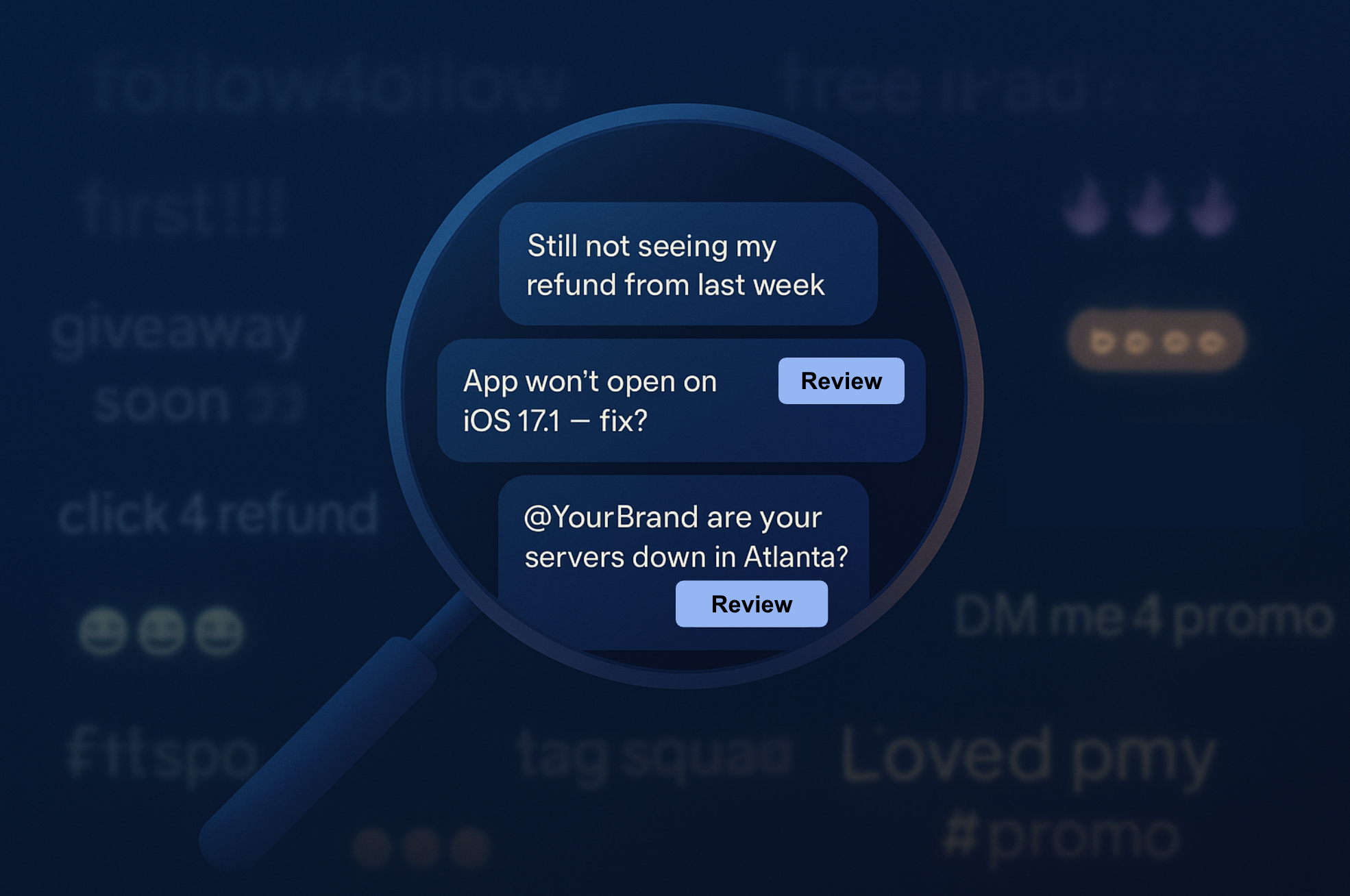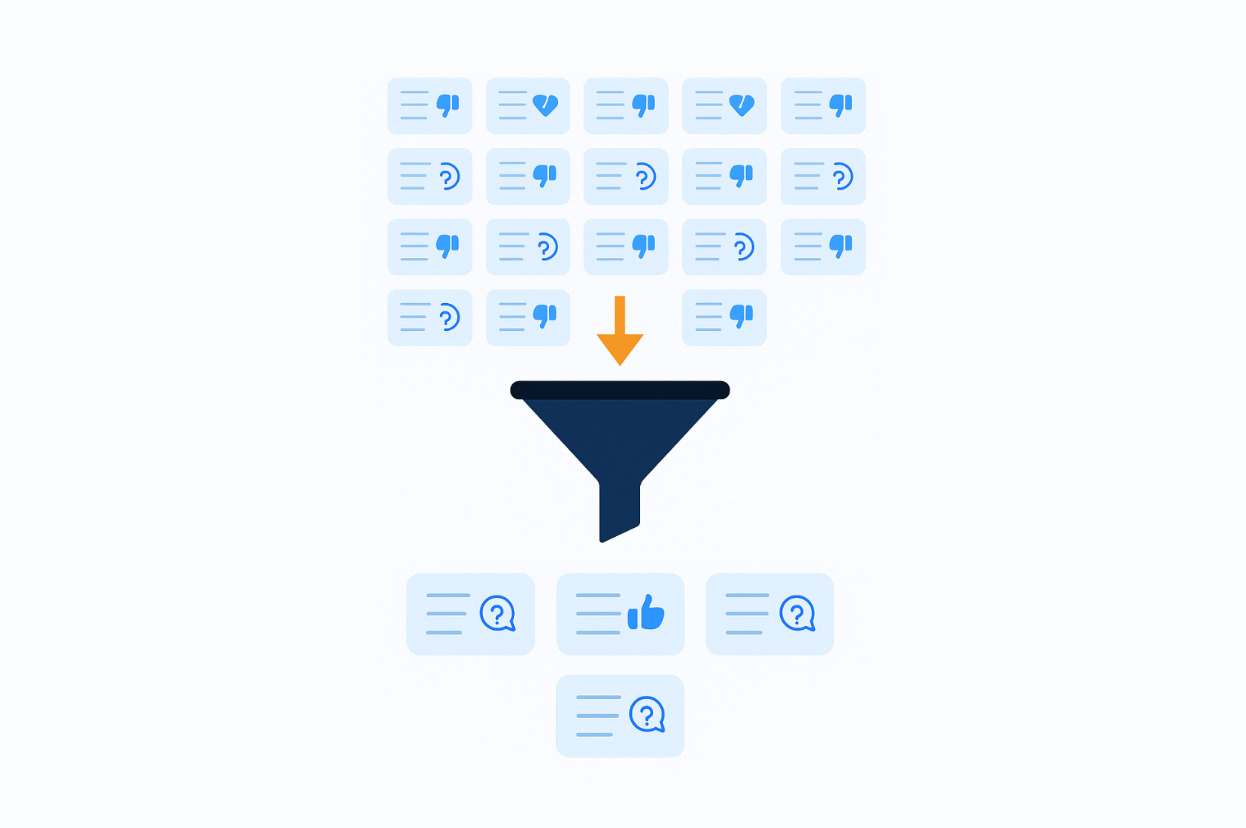From Keywords to Context: A New Era of Social Care
Why social media support teams are moving past keyword monitoring, and what you need to keep up.

Imagine this: You’re running social care for a major brand. Every day, your team is bombarded with thousands of posts, tweets, tags, and DMs—most of them noise. In fact, up to 85% of what’s said about your company on social media platforms is completely irrelevant, uninsightful, or otherwise useless. It’s just chatter: off-topic, spammy, or not something you could ever act on.
But with the right AI, that problem flips on its head. An effective social care and community support AI agent can automatically filter out that 85% of noise, surfacing only the actionable, insightful, or critical 15% without human triage or constant keyword rule iteration. You could automatically go from processing 10,000 messages a day, to processing 1,500 messages that involve real support cases or invaluable business intelligence. Even a conservative estimate, filtering out ~70% of irrelevant messages, saves your team hundreds of hours and ensures nothing important slips through the cracks. This is the real-world impact of moving from legacy keyword filters to context-aware AI agents that understand intent and relevance.
In this blog post, we will explore the shortcomings of keyword-first social care, the advantages AI have enabled, and what it means for your social media and community support workflows.
The Old Playbook: Keywords, Dashboards, and Reactive Chaos
Social care and support teams are busier than ever. With customers reaching out across X, Instagram, Facebook, WhatsApp, and more, every brand is now always-on, public-facing, and one viral thread away from disaster, or delight.
Traditionally, social media care teams relied on a familiar formula:
- Keyword monitoring: Setting up “watch lists” for terms like “broken,” “not working,” “refund,” the brand’s name, or something else.
- Volume dashboards: Tracking spikes in keywords and mentions, often after an issue has already exploded.
- Manual review: Assigning staff to dig through mountains of threads, tags, and notifications to find what truly matters.
- Triage and case management: Copy-pasting issues into internal tools, manually assigning tickets, and hoping nothing slipped through.
This system worked decently when volumes were lower and the number of platforms was manageable. But it’s no longer enough.
The Scale of the Challenge: By the Numbers
For today’s largest brands (think tech giants, global telecomms, or consumer apps), social media and community teams are responsible for monitoring and responding to thousands, sometimes millions, of messages every month. A household name brand might see 10,000+ customer mentions per day across X, Facebook, Reddit, Discord, WhatsApp, or niche forums. Even a mid-sized brand may be expected to manage hundreds of new support threads, DMs, product questions, and complaints every single shift.
Manually reviewing this flood of conversations isn’t just exhausting; it’s nearly impossible. A team of 20 agents can easily spend 80+ hours per day simply sorting, tagging, and assigning messages. On average, it can take anywhere from 5 to 20 minutes just to identify, categorize, and route a single complex thread to the right owner before anyone has even started resolving the case. For companies scaling up, the cost of hiring, training, and retaining enough people to keep up can spiral into millions of dollars per year, with diminishing returns.
The sheer volume, speed, and fragmentation of digital conversations have turned what was once a manageable workflow into an operational minefield. One where critical signals are buried, support teams burn out, and customers wait too long for answers.
But raw volume is just the tip of the iceberg. Once you dig into the details, the complexity only multiplies. Fragmented threads, ambiguous intent, and platform-specific quirks make it even harder to separate urgent issues from everyday chatter. This is especially true in keyword-oriented workflows.
What’s Broken with Keyword-First Social Media Support?

As brands have embraced more digital channels, several core challenges have emerged:
Signal Drowns in Noise
- Most keyword hits are irrelevant: spam, jokes, memes, duplicate posts, or just a whole nother subject matter.
- Context is lost. “Lyft” might refer to ridesharing services, or just a meme for gym bros.
- Teams waste hours reviewing false positives instead of helping real customers.
Critical Signals Get Missed
- People use sarcasm, regional slang, emojis, or code words; keywords alone can’t catch subtle, urgent, or emerging issues.
- Language barriers: Multilingual communities mean important threads in different languages slip by unnoticed.
- Support requests can double as feedback, product ideas, and complaints. Most keyword tools can’t synthesize or distinguish between them.
Late Detection Means Lost Opportunities
- Most dashboards only show you problems after they’re trending.
- Delayed escalations can turn small issues into viral crises.
- “After the fact” reporting leaves leaders guessing about root causes and prevention.
Manual Work Doesn’t Scale
- Teams spend hours tagging, summarizing, and routing cases.
- Burnout increases as agents triage repetitive issues, while meaningful customer connections get sidelined.
- Managerial reviews are retroactive and time-consuming.
The bottom line: More channels and more volume equals more manual work, noise, and blind spots.
The Shift to Context: AI’s Promise for Social Media Support
Modern customers expect brands to listen, understand, and respond immediately. The breakthrough? Large Language Models (LLMs) and next-gen AI are finally able to make sense of messy, high-volume conversations at scale.
Here’s what context-aware AI unlocks:
Actionable Relevance
- AI distinguishes real support requests from jokes, small talk, or off-topic chatter.
- Only actionable items surface, saving your team hundreds of hours a year.
True Understanding. Not Just Matches.
- Conversations are tagged and classified by sentiment, urgency, and topic, not just by keywords.
- Multilingual support means nothing gets missed, no matter the language. This includes sarcasm and slang.
- Multimodal support means emojis, memes, and even images are interpreted in context, so subtle signals are recognized.
End-to-End Automation
- AI creates and manages “actions” from any channel, whether it’s a complaint on Instagram, a feature request on Discord, or an inquiry on Reddit.
- Cases are auto-assigned to the right queue, agent, or team. No manual triage required.
- Replies can be automated for routine issues, freeing up human agents for complex care.
Real-Time Performance Insight
- Dashboards now reflect live action items, unresolved cases, and trending pain points.
- Agent and action review is automated. Leaders instantly see response times, customer satisfaction, and how cases are handled.
- Escalations, follow-ups, and handoffs are tracked across platforms and teams.
Operational Headaches Solved by Context-Driven AI
Let’s break down what actually changes when you move to context, not just keywords:
- No more missed DMs or buried mentions: AI brings every relevant message, no matter where it happens, into a single view.
- Reduced manual triage: Auto-tagging, summarization, and escalation means your team can focus on resolving, not sorting.
- Better, faster decisions: Leaders get real-time visibility into workload, trends, and performance, without waiting for a data team.
- Fewer fires, more loyalty: Issues are caught early; positive feedback and suggestions get acted on, not lost in the crowd.
- Scalable support: As you add new channels or grow your audience, AI handles the volume without adding more staff.
Sift AI: Built for the Realities of Modern Social Care
Here’s how Sift redefines the workflow for leading brands: AI Agents.
What Is an AI Agent?
AI agents are specialized, autonomous software programs designed to handle specific tasks within your social media or community workflow. Each agent leverages machine learning and natural language understanding to continuously monitor, interpret, and act on real-time conversations across multiple platforms.
The purpose of an AI agent is to automate repetitive tasks, surface critical insights, and ensure that the right actions are taken at the right time. This enables your team to focus on what matters most: building relationships, resolving issues, and growing your community. With Sift, every unique feature is powered by an agent that works 24/7, adapting to the unique needs and challenges of modern customer care.
Sift takes this concept further by offering a robust suite of AI agents — each purpose-built to manage, analyze, and automate every aspect of your social care and community operations.
Listening Agent
Monitors all your social media and community channels in real time, automatically surfacing the most relevant questions, feedback, and signals that need action so you never miss what matters.
Insights Agent
Transforms the flood of daily conversations into actionable insights, sentiment, trends, and recurring topics so you can make fast, informed decisions.
Operations Agent
Routes, tags, summarizes, prioritizes, and assigns each action to the right queue or team. This ensures an efficient workflow, reducing manual triage and keeping your team focused on high-impact work.
Support Agent
Enables your team to respond directly to customers across any platform, automates replies for routine questions, and tracks case status to ensure nothing goes unresolved.
Agent & Action Review
Analyzes support cases and agent activity, providing your leaders with feedback, performance trends, and coaching opportunities so you can continually improve your social care operations.
Custom AI Agents
Configurable to your unique needs, Custom Agents let you define specialized automations. Whether it’s preventing leaking PII, reviewing posts, tagging users, or whatever else you need.

Example Use Case: Telecomms Industry
Telecommunications companies face nonstop customer questions, outage alerts, feedback, and complaints across social media platforms. For brands like Verizon, AT&T, T-Mobile, etc., the challenge isn’t just high message volume; it’s the stakes. A missed signal can mean lost customers, public backlash, or viral complaints about service disruptions.
With Sift AI, telecom social and support teams get a unified inbox that pulls in every mention about dropped calls, slow data, or billing issues no matter where it’s posted.
Listening Agent: Instantly detects emerging outage complaints, dropped call reports, or 5G coverage issues on platforms like X and Reddit, alerting your support teams before they escalate, helping prevent negative sentiment that drives subscriber churn.
Operations Agent: Sorts and routes cases such as porting requests, billing errors, or SIM swap fraud suspicions to specialized telecom teams, ensuring experts handle high-risk or complex scenarios that could otherwise result in lost customers.
Support Agent: Sends real-time troubleshooting steps to customers facing connectivity problems via WhatsApp or Facebook Messenger, proactively follows up with dissatisfied users, and escalates technical issues to field support if needed, reducing frustration and improving retention.
Insights Agent: Surfaces trends like recurring slow data speeds in a specific region, device setup confusion after a new launch, or sudden surges in roaming complaints, so product, engineering, and CX teams can address root causes and identify early signals of churn risk.
With Sift, companies stay ahead of the curve, delivering proactive, transparent, and highly responsive support across every customer channel, building stronger relationships and setting a new standard for modern engagement.
Are You Ready for Context-Driven Social Care?
If your social care still relies on keyword matches and manual tagging, you’re missing the signals, and the speed, your customers demand.
Book a demo to see how Sift AI Agents can help your team listen, understand, and act where it matters most. Without drowning in noise.
Explore Sift For Your Team
Related posts

How AI Powers Social Monitoring and Trend Analysis Across Today’s Digital Communities
Let's turn our attention to AI-powered social monitoring and trend analysis—processes that help you stay ahead of what customers care most about.

LLMs for Social Media Sentiment Analysis: A Technical Look
In this blog post, we’ll take a technical look at how LLMs can be used for superior sentiment analysis, the challenges involved, and the unique advantages they offer – particularly as it pertains to social media and community platforms.
